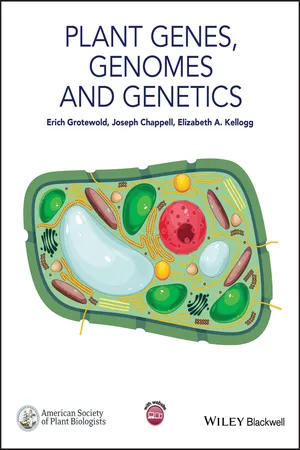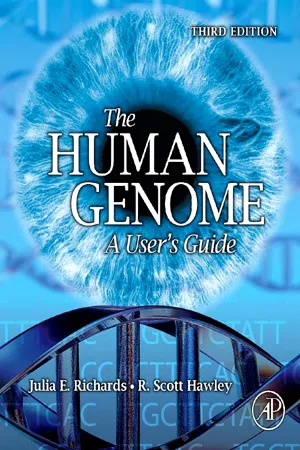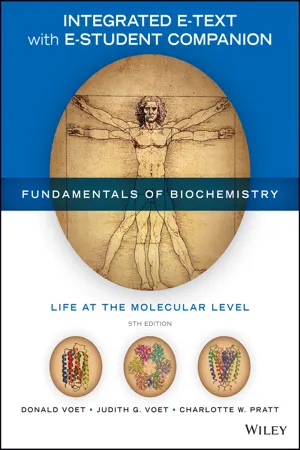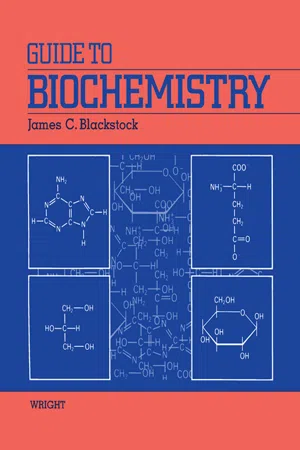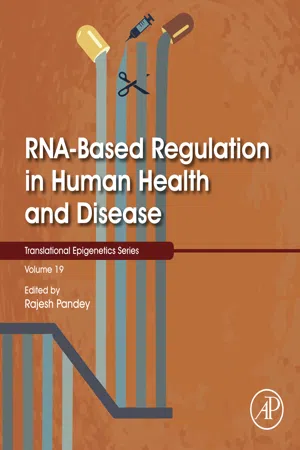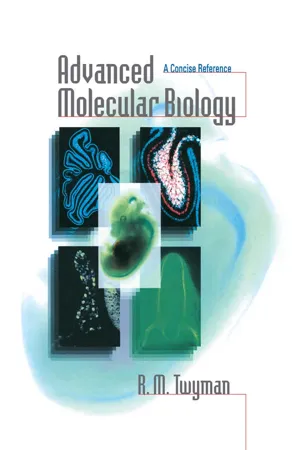Chemistry
messenger RNA
Messenger RNA (mRNA) is a type of RNA molecule that carries genetic information from the DNA in the cell nucleus to the ribosomes in the cytoplasm. It serves as a template for protein synthesis, carrying the instructions for the sequence of amino acids in a protein. mRNA plays a crucial role in the process of gene expression and protein production within cells.
Written by Perlego with AI-assistance
Related key terms
8 Key excerpts on "messenger RNA"
- eBook - ePub
- Erich Grotewold, Joseph Chappell, Elizabeth A. Kellogg(Authors)
- 2015(Publication Date)
- Wiley-Blackwell(Publisher)
Yet, as will be described below, it is now clear that information can also flow from RNA to DNA, and thus the Central Dogma is not as unidirectional as originally thought. RNA plays a central role in this flow of information. However, we will also see that RNA has a number of other fundamental cellular functions, including structural and catalytic roles. A typical eukaryotic cell, such as a plant cell, carries many distinct types of RNA molecules, which can be differentiated by some unique characteristics (Figure 6.2 and Table 6.1). messenger RNA (mRNA), corresponding to just 2–4% of the total RNA in the cell, conveys the bulk of the genetic information from the DNA to the proteins. mRNAs can range in size from a few hundred to several thousand nucleotides. They typically carry a cap at the 5′ end, consisting of modified guanine nucleotide and a 3′ tail formed by up to several hundred adenosine nucleotides (polyA tail). RNA modifications are discussed at the beginning of Part 3 of this book, and mRNAs are a main focus of Chapter 8. Figure 6.1 The Central Dogma of Biology. Arrows indicate the flow of information Figure 6.2 Diagrams showing main characteristics of various RNAs (tRNA, rRNA and mRNA). The different colors in the tRNA illustrate the various arms and loops. For example, the orange corresponds to the D arm and loop, the red corresponds to the anticodon arm and loop, the green corresponds to the T arm and loop, and the blue corresponds to the amino acid acceptor arm (the amino acid gets covalently linked to the 3′ end, which harbors the –OH group) - eBook - ePub
- Julia E. Richards, R. Scott Hawley(Authors)
- 2010(Publication Date)
- Academic Press(Publisher)
Many RNAs seem like a kind of molecular “photocopy,” carrying disposable information out of the nucleus to be used before tossing the photocopy into the recycle bin, while the original hard-bound book stayed safely in the library of the nucleus, available to be used again and again. The type of RNA that carries information from the nucleus to the ribosomes, called messenger RNAs or mRNAs, contains coding sequence that the cell can decode to direct the synthesis of proteins. Only part of the mRNA contains the protein sequence. There are also regions at the 5′ end and at the 3′ end of the transcript that do not contain coding sequence, but rather play roles in determining processes such as the localization of the mRNA in the cell and its stability.For a long time we thought of other types of RNA as mostly playing support roles for this messenger function. But the field of molecular genetics has become increasingly aware that there are a wide array of different kinds of RNAs, not just mRNAs and helper RNAs playing supporting roles for the use of mRNAs. It turns out that many different kinds of RNA qualify as non-coding RNA, that is to say, as RNA that does not contain a sequence to be decoded by the ribosomes or direct the synthesis of proteins (Table 3.1 ). What are some of these non-coding RNA functions?Table 3.1 Examples of different types of RNA and the role they play in the cellType of RNA Also called Function messenger RNA mRNA Tells ribosomes the order in which to add amino acids to the growing protein chain Ribosomal RNA rRNA Part of the ribosome that “reads” mRNAs Transfer RNA tRNA Brings amino acids to the ribosome and helps the ribosome insert the amino acid into the growing protein chain Heterogeneous nuclear RNA hnRNA Unprocessed or partially processed transcripts not yet ready for use Small nuclear RNA snRNA Part of the machinery that processes RNA molecules Small nucleolar RNA snoRNA 60–300 bases. Help with chemical modification of rRNAs, tRNAs, and snRNAs - eBook - ePub
Fundamentals of Biochemistry, Integrated E-Text with E-Student Companion
Life at the Molecular Level
- Donald Voet, Judith G. Voet, Charlotte W. Pratt(Authors)
- 2017(Publication Date)
- Wiley(Publisher)
protein synthesis is not immediately directed by DNA because, at least in eukaryotes, DNA and ribosomes are never in contact. The intermediary between DNA and the protein-biosynthesis machinery, as outlined in Francis Crick's central dogma of molecular biology (Section 3-3B ), is RNA.Cells contain three major types of RNA:ribosomal RNA (rRNA), which constitutes two-thirds of the ribosomal mass;transfer RNA (tRNA), a set of small, compact molecules that deliver amino acids to the ribosomes for assembly into proteins; andmessenger RNA (mRNA), whose nucleotide sequences direct protein synthesis. In addition, a host of othernoncoding RNAspecies play various roles in the regulation of gene expression and the processing of newly transcribed RNA molecules (Table 26-1). All types of RNA can be shown to hybridize with complementary sequences on DNA from the same organism. Thus, all cellular RNAs are transcribed from DNA templates.GATEWAY CONCEPT: The Central Dogma
RNA synthesis represents one step of the central dogma of molecular biology, in which the information encoded in DNA is rewritten (transcribed) in the form of RNA. The RNA may undergo extensive modification before it is used, and it is relatively quickly degraded, but the information in DNA remains intact. - eBook - ePub
Advanced Chemical Biology
Chemical Dissection and Reprogramming of Biological Systems
- Howard C. Hang, Matthew R. Pratt, Jennifer A. Prescher, Howard C. Hang, Matthew R. Pratt, Jennifer A. Prescher(Authors)
- 2023(Publication Date)
- Wiley-VCH(Publisher)
4 RNA Function, Synthesis, and Probing Andreas Pintado‐Urbanc1 ,2and Matthew D. Simon1 ,21 Department of Molecular Biophysics and Biochemistry, Yale University, 266 Whitney Ave, New Haven, CT, 06511, USA 2 Institute of Biomolecular Design and Discovery, Yale University, 600 West Campus Dr, West Haven, CT, 06516, USA4.1 Introduction
How did life begin? There is ample evidence to support the hypothesis that life began with an RNA world [1] . RNA has the capacity to both encode information in its primary sequence and to perform complex functions (plausibly including self‐replication). This is because of its ability to fold into intricate three‐dimensional structures. Relics of the RNA world can be found throughout the pantheon of biomolecules, notably through the prevalence of ribonucleotides in cofactors, such as adenosine triphosphate (ATP ), nicotinamide adenine dinucleotide (NAD+), and acetyl‐CoA. In modern life, RNA is at the heart of the central dogma of molecular biology, enabling the sequential flow of genetic information (DNA → RNA → protein). Additionally, RNA carries out a broad range of biological functions beyond coding for proteins. As will be explored in Chapters 4 and 5 , the chemical biology of RNA is central to the study and manipulation of biology, especially regulated gene expression. In this chapter, we will explore the chemical properties and principles of RNA molecules. Chapter 5 will extend this exploration to the regulatory roles of RNA in gene expression.The chemistry and biology of RNA are often closely aligned with that of DNA, the fundamental principles of which are described in Chapter 3 . As nucleotide chemistries are frequently portable, RNA chemical synthesis (Section 4.4.1 ) and sequencing strategies (Section 4.5 - eBook - ePub
- James C. Blackstock(Author)
- 2014(Publication Date)
- Butterworth-Heinemann(Publisher)
CHAPTER 17Gene expression
Publisher Summary
This chapter presents the concept of gene expression. The concept of the central dogma of molecular biology, formulated in the late 1950s by Francis Crick may be summarized as DNA (deoxyribonucleic acid) →RNA (ribonucleic acid) →protein. Transcription is the process in which RNA is synthesized by enzymes called DNA-directed RNA polymerases. These enzymes use ribonucleoside triphosphates as substrates and DNA as a template. Specific base sequences signal the termination of transcription. Transcription produces RNA molecules. Translation involves two compartments: the cytosol in which individual amino acids are enzymically attached to their specific tRNAs by amino-acid-tRNA ligases and the ribosomes in which the amino acids are correctly positioned according to the base sequence of a mRNA template and polymerized into polypeptide chains. As there are four major bases in mRNA, 43 different codons are possible. The 64 triplets constitute the genetic code. The genetic code applies to prokaryotes and eukaryotic nuclear and chloroplast mRNAs but not to mitochondrial mRNAs. Therefore, the genetic code is quasi-universal.17.1 The central dogma
The concept of the central dogma of molecular biology (Section 1.6 ), formulated in the late 1950s by Francis Crick may be summarized as DNA (deoxyribonucleic acid) → RNA (ribonucleic acid) → protein.In all living organisms, nuclear DNA serves as the reservoir of genetic information which is expressed in terms of the structure of proteins manufactured by the cell. The base sequence of the DNA determines the amino acid sequence of proteins which are responsible for all aspects of cellular function. Because of cellular organization, synthesis of protein from the DNA blueprint occurs in two stages: transcription, i.e. the synthesis of a messenger RNA molecule of a structure complementary to the structure of DNA so that the genetic information is transferred to mRNA, and upon delivery of the message to the cytosol, its translation into protein. - eBook - ePub
- (Author)
- 2020(Publication Date)
- Academic Press(Publisher)
Fig. 11.1 ). In the sections to follow, we will focus on the particular classes of the ribonucleic acids that may affect the tumor initiation, progression and treatment. The boundaries of division will follow the well-established classification of RNAs based on their functionality, at least whenever possible - in the end they all present the intricate, richly interwoven mosaic of dependencies that cannot be simply cut without oversimplification. Thus, cancer-relevance of mRNAs, tRNAs, rRNAs and ncRNAs will be discussed, taking an angle of the solely RNA biology, to bring this so far second plan actor from the backstage to the limelight, where it belongs.messenger RNA in cancer
No one loves the messenger who brings bad news/Sophocles, Antigone.messenger RNA (mRNA) for the long time was laying in the center of the interest for the scientific RNA world. It conveys genetic information from DNA to the ribosome, encrypting the amino acid sequence of the protein products. Simplistically, the life of mRNA starts from the transcription of DNA to precursor mRNA (pre-mRNA) by RNA polymerase II. Then, the pre-mRNA is processed by the splicing machinery that cuts and stiches back the transcripts to remove the introns, further polyadenylated and capped with 7-methylguanosine. Emerging evidence indicates that mRNA is also modified at the level of single nucleotides to expand the nucleic acid code beyond four basic nucleotides in a process termed epitranscriptomics (per analogiam to epigenetics). And finally, mRNA is translated to give rise to the mature proteins. In the following sections, we dissect the splicing, epitranscriptomic and translational code of mRNA and discuss how it may be affected in cancer-related processes.Fig. 11.1 All of the hallmarks of cancer, typical for different types of malignancies are affected at the level of RNA biology. uORF - upstream open reading frame, tRFs - tRNA-derived fragments.Alternative splicing
Splicing is a fundamental process governing the coding capacity of a genome. High throughput RNA sequencing analysis of cellular transcriptomes revealed that nearly all precursor mRNAs are processed by the splicing machinery termed spliceosome [4 ]. It removes introns and joins exons to generate multiple mRNA variants from a single gene, a process known as alternative splicing (AS). As such, AS has a paramount role in shaping cellular transcriptomes in a large variety of fundamental processes involved in development and tumorigenesis [5 - Naoki Sugimoto(Author)
- 2021(Publication Date)
- Wiley-VCH(Publisher)
7 TranslationThe main points of the learning- Study basic molecular mechanisms of translation reaction.
- Understand presence of various reaction steps for translation modulation and maintenance.
- Study contributions of RNA structures to the translation modulation.
7.1 Introduction
Protein is biopolymer consisting of amino acids polymerized in one dimension. In living system, the amino acid sequence of each protein is encoded in the sequence of messenger RNA (mRNA) that is originally encoded in DNA sequence. The sequence code on mRNA is decoded by a ribosome though a reaction termed translation. Since the protein is the main functional molecule in extant living system, translation is one of the most important biological reactions. Intracellular protein expression is modulated at not only transcription level but also at translation level. The formation of unique RNA structures and their dynamic behaviors are the key factors to modulate and maintain the translation system. This chapter describes contribution of RNA structures on translation reaction as well as its basic knowledge. The contributions of structure dynamics of RNAs on gene expressions including replication, transcription, and translation are described in Chapter 10 .7.2 RNAs Involved in Translation Machinery
There are three categories of RNAs such as mRNA, tRNA, and rRNA, which are directly involved in translation machinery. mRNA is a template for the translation. A region of nucleotide sequence in mature mRNA that is translated to a given protein is known as an open reading frame (ORF) (Figure 7.1 ). Correlation between nucleotide sequence and amino acid sequence was first proposed by Francis Crick as a sequence hypothesis. George Gamow, who is a theoretical physicist and cosmologist famous for his big bang theory, proposed that specific trinucleotide encodes one specific amino acid. The trinucleotide, which encodes a specific amino acid, is now known as a codon. Correlations between each codon and amino acid, which are conserved in all extant living system with few exceptions, have resolved by contributions from Marshall Nirenberg and Har Khorana (Figure 7.2 ). Outside of coding sequence, mRNA contains noncoding sequences. Untranslated regions (UTRs) at 5′ and 3′ ends of mRNA are called 5′ UTR and 3′ UTR, respectively. Prokaryotic mRNAs are polycistronic, which contains multiple ORFs in one mRNA. There are noncoding sequences between adjacent ORFs. In the case of eukaryotic mRNAs, primary transcript is a precursor messenger RNA (pre-mRNA) consisting of alternating exon and intron regions. Noncoding introns are excluded by posttranscriptional splicing that result in connected exons as a mature mRNA (Figure 7.1- eBook - ePub
Advanced Molecular Biology
A Concise Reference
- Richard Twyman(Author)
- 2018(Publication Date)
- Garland Science(Publisher)
It must fold correctly, a process sometimes requiring the assistance of a molecular chaperone (q.v.). It may be cleaved, and specific residues may be chemically modified or conjugated to small molecules. Such modifications are often associated with the targeting of proteins to specific compartments in the cell or for secretion. Proteins may need to associate noncovalently with other proteins or with nonpolypeptide cofactors for their full activity. For a discussion of these processes, see Proteins: Structure, function and evolution. 23.1 The components of protein synthesis messenger RNA. messenger RNA (mRNA) is the template for protein synthesis. It has two essential features: an open reading frame (a sequence of translatable codons) and a ribosome binding site (where the small ribosome subunit binds and the rest of the ribosome assembles). There are important distinctions between prokaryotes and eukaryotes with respect to the organization of these sites, and also concerning other aspects of the life of a typical mRNA molecule. These differences and their consequences are summarized below. (1) In bacteria, transcription and translation occur simultaneously in the same cellular compartment, whereas in eukaryotes, transcription is restricted to the nucleus and RNA must be exported into the cytoplasm for translation. (2) Bacterial mRNA has a limited half-life (several minutes for the most stable transcripts). Some eukaryote mRNAs are also unstable, but most are stable for hours or even days (e.g. in eggs). (3) Bacterial transcripts are used directly for translation, whereas eukaryotic transcripts are extensively processed and modified beforehand. Processing reactions include the splicing of introns and 3′ end polyadenylation; both may regulate the efficiency of translation, either directly or by modulating mRNA stability. A further modification is the synthesis of a 5′ end 7-methylguanosine cap, which has a direct role in ribosome binding
Learn about this page
Index pages curate the most relevant extracts from our library of academic textbooks. They’ve been created using an in-house natural language model (NLM), each adding context and meaning to key research topics.
